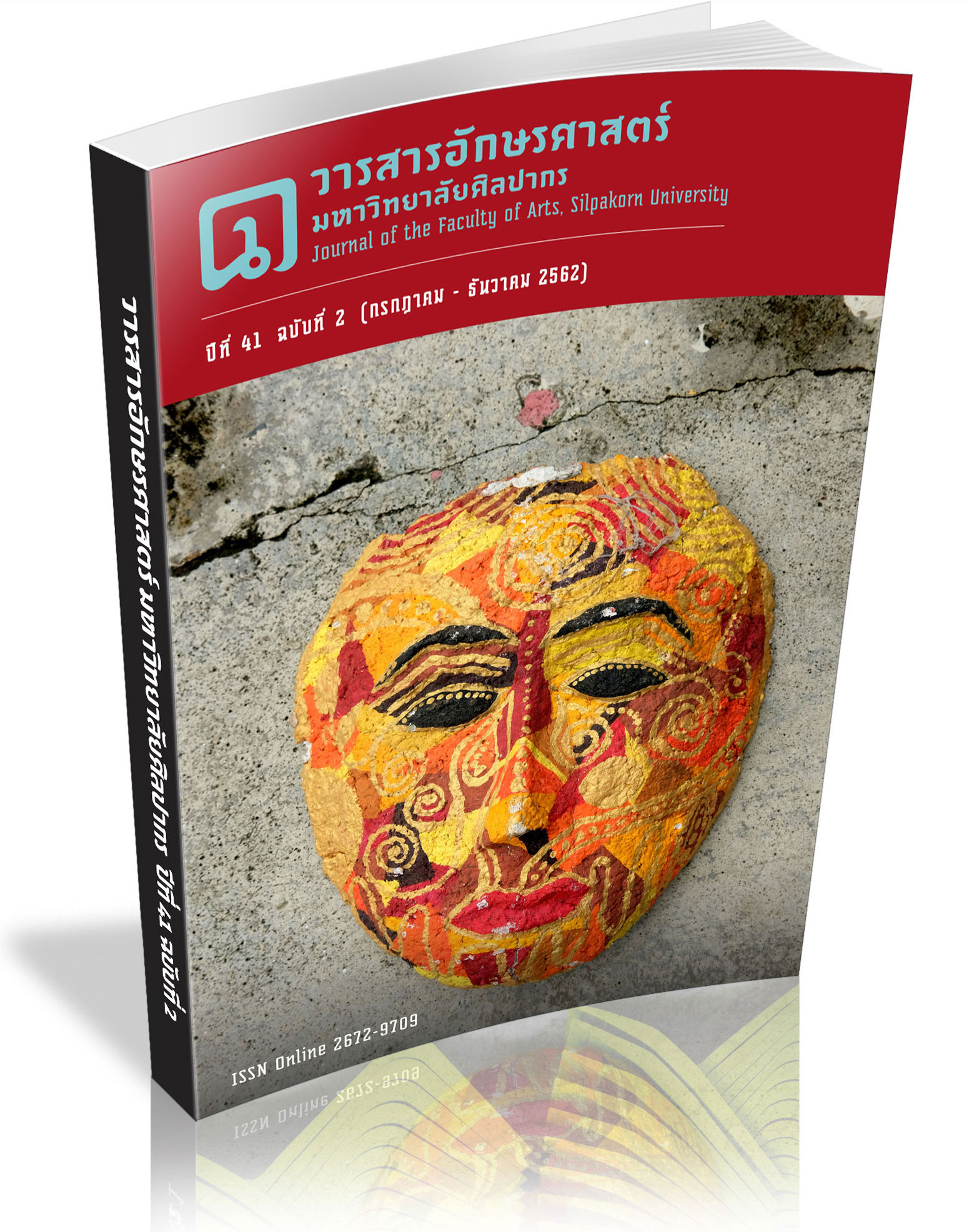ลำสีพันดอน
หมอลำพื้นบ้าน แขวงจำปาสัก สาธารณรัฐประชาธิปไตยประชาชนลาว
คำสำคัญ:
ลำสีพันดอน, หมอลำบทคัดย่อ
การวิจัยนี้ มีความมุ่งหมายเพื่อศึกษาวิวัฒนาการ องค์ประกอบ และบทบาทการขัดเกลาทางสังคมของลำสีพันดอน : หมอลำพื้นบ้าน แขวงจำปาสัก สาธารณรัฐประชาธิปไตยประชาชนลาว ผู้วิจัยใช้ระเบียบวิธีวิจัยเชิงคุณภาพทางมานุษยดุริยางควิทยา (Ethnomusicology Qualitative Research) โดยการลงพื้นที่วิจัยเพื่อทำการเก็บรวบรวมข้อมูลในเชิงลึก ด้วยวิธีการสังเกตและสัมภาษณ์ นำข้อมูลมาวิเคราะห์และนำเสนอในรูปแบบเชิงพรรณนาวิเคราะห์ ผลการวิจัย พบว่า วิวัฒนาการของลำสีพันดอน แบ่งออกเป็นยุคสมัย ได้แก่ ยุคเริ่มต้น ตั้งแต่ปี ค.ศ. 1900 ถือกำเนิดขึ้นพร้อมกับลำโสม โดยลำโสมเป็นทำนองการลำของพ่อเฒ่าโสม ซึ่งเป็นแนวทำนองการอ่านหนังสือเกี่ยวกับเรื่องราวของวรรณคดี นิทานพื้นบ้าน คติสอนใจ ในงานบุญประเพณีและงานสมโภชต่างๆ เช่น งานบวช งานกฐิน งานทำบุญให้ผู้เสียชีวิตล่วงลับไปแล้ว เป็นต้น ต่อมาพ่อเฒ่าโสมได้ปรับเปลี่ยนวิธีการอ่านหนังสือ โดยอ่านเป็นท่วงทำนองให้มีเสียงสูงและเสียงต่ำขึ้นลงสลับกันไป มีจังหวะช้าๆ ทำให้ได้รับความนิยมจากคนฟังและเรียกว่า “ลำโสม” ส่วนลำสีพันดอน มีท่วงทำนองลำกระชับและเร็วกว่าลำโสม เป็นการลำคู่ที่มีหมอลำผู้ชายและหมอลำผู้หญิงแสดงคู่กัน วิธีการแสดงเป็นการลำโต้ตอบกัน เนื้อหาสาระของกลอนลำ ประกอบด้วย ลำไหว้ครู ลำถามข่าว ลำเกี้ยว ลำกระทู้ ลำอวยศรัทธาเจ้า ภาพ และลำลา เครื่องดนตรที่ใช้ประกอบ คือ แคน ยุคปรับเปลี่ยน ลำสีพันดอนเริ่มมีการปรับเปลี่ยน ในช่วง ปี ค.ศ. 1925 โดยพ่อวันนา แก้วพิลม เป็นผู้พัฒนาวิธีการแสดง จังหวะและท่วงทำนองลำสีพันดอนขึ้นใหม่ให้เร็วและกระชับขึ้น และนำเครื่องดนตรีประกอบจังหวะมาตีประกอบ ได้แก่ กลอง และฉาบ ทำให้เกิดความสนุกสนานเร้าใจยิ่งขึ้น ส่วนในยุคปัจจุบัน ราวปี ค.ศ. 1990 ได้นำทำนองลำแบบต่างๆ มาสลับช่วงการแสดงกับลำสีพันดอนเพื่อให้เกิดความหลากหลายของการแสดง เช่น ลำซิ่ง ลำตังหวาย และลำคอนสะหวัน เป็นต้น องค์ประกอบของลำสีพันดอน ประกอบด้วย ถ้อยคำภาษา กลอนลำ ฉันทลักษณ์กลอนลำ เนื้อหากลอนลำ จังหวะและทำนอง เครื่องดนตรีที่ใช้ประกอบลำสีพันดอน คือ แคน ชนิดแคนแปด มีความยาวสองศอกคืบ (2 ศอกกับอีก 1 คืบ) ลายที่เป่า คือ ลายสร้อยเป็นทางสำหรับหมอลำผู้หญิง และลายเป้ยเป็นทางสำหรับหมอลำผู้ชาย ซึ่งจะมีเสียงสูงกว่าลายสร้อย ส่วนบทบาทการขัดเกลาทางสังคมของลำสีพันดอน ได้แก่ ใช้ขัดเกลาทางด้านจิตใจ ด้านสติปัญญา และด้านพฤติกรรมขึ้น ในยุคปัจจุบัน ราวปี ค.ศ. 1990 ได้นำทำนองลำแบบต่างๆ มาสลับช่วงการแสดงกับลำสีพันดอนเพื่อให้เกิดความหลากหลายของการแสดง เช่น ลำซิ่ง ลำเพลิน ลำตังหวาย ลำคอนสะหวัน เป็นต้น องค์ประกอบของลำสีพันดอน ประกอบด้วย ถ้อยคำภาษา กลอนลำ ฉันทลักษณ์ กลอนลำ เนื้อหากลอนลำ จังหวะทำนอง ลำสีพันดอนในยุคเริ่มต้นจะมีจังหวะปานกลาง ทำนองจะเป็นทำนองสั้นๆ ทำนองเดียวตลอดทั้งกลอนลำ เครื่องดนตรีที่ใช้ประกอบลำสีพันดอน คือ แคน ชนิดแคนแปด มีความยาวสองศอกคืบ (2 ศอกกับอีก 1 คืบ) ในยุคปัจจุบันนำเครื่องดนตรีประกอบจังหวะมาตีประกอบ ได้แก่ กลอง และฉาบ ทำให้เกิดความสนุกสนาน เร้าใจยิ่งขึ้น ลายที่เป่า คือ ลายสร้อยเป็นทางสำหรับหมอลำผู้หญิง และลายเป้ยเป็นทางสำหรับหมอลำผู้ชาย ซึ่งจะมีเสียงสูงกว่าลายสร้อย บทบาทการขัดเกลาทางสังคมของลำสีพันดอน ได้แก่ ใช้ขัดเกลาทางด้านจิตใจ ด้านสติปัญญา และด้านพฤติกรรม
Downloads
เอกสารอ้างอิง
Chonpairoj, C. (1987) “Esan Local Music” The Journal of Srinakharinwirot University, Mahasarakham campus, Chalerm edition In honoring and paying tribute to the memory and legacy of His Majesty the late King Bhumibol Adulyadej, Srinakharinwirot University.
11th edited. Mahasarakham : Srinakharinwirot University, Mahasarakham campus.
Kaewbualar, B. (2018). interviewed by Anan Meechai at the office of Mor Lam Dok Phonthong band, Ban Khunyaeng, Muang Phonthong band, Champasak, Lao PDR.
________ . (1983). Mor Lam-Mor Kan. Bangkok : Aksorn Samai. Kritsada Suksumnieng. (2006). Mor Lam Sriphundorn: Case Study of Thong Bang Kaewsuwan, Pakse, Champasak, Lao PDR. Master Thesis(Ethnic Musical Science) Graduated School Kasetsart University.
________ . (2014). Local Performance in the south of Lao PDR. Doctor Thesis (Arts of Playing Music) Mahasarakham University. Mercer, B. E. & Merton, R. k. (1958). The study of Society. New York : Harcout and World.
Thammawat, J. (1997). Esan local people’s motto. Bangkok : Aksornwattana.
Thammawat, J. et al. (1997). Document for Seminar “Art status and heritage guideline Mor Lam performance” by Cultural Empowerment Fund, Office of the National Culture Commission together with Esan academician group. Mahasarakham : Cultural Empowerment Fund.
Weerawong , J. (2019). interviewed by Anan Meechai at Ban Huai Khong Payai, Muang Khong, Champasak, Lao PDR.
ดาวน์โหลด
เผยแพร่แล้ว
รูปแบบการอ้างอิง
ฉบับ
ประเภทบทความ
สัญญาอนุญาต
ผู้เขียนบทความต้องยินยอมในข้อกำหนดต่าง ๆ ของวารสารก่อนส่งบทความตีพิมพ์




